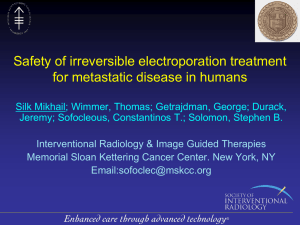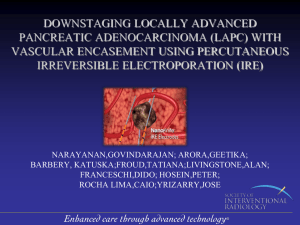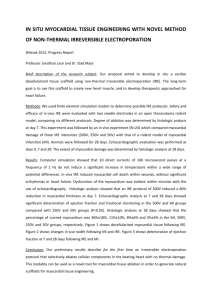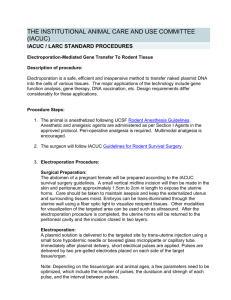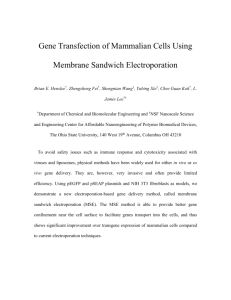Technol Cancer Res Treat
advertisement
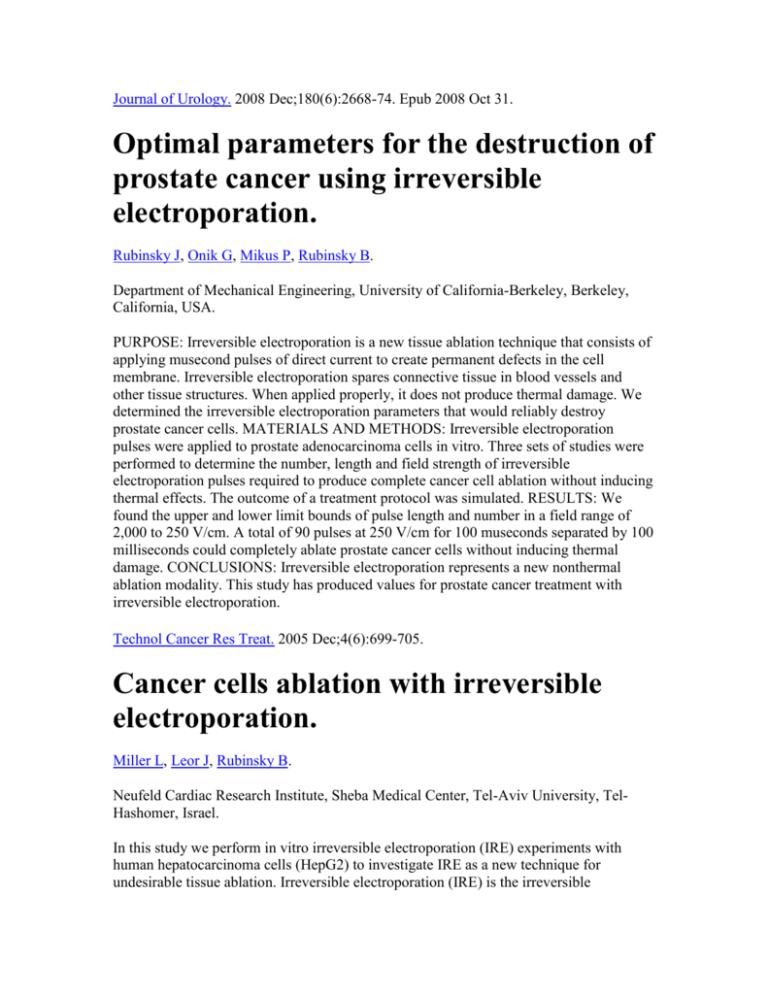
Journal of Urology. 2008 Dec;180(6):2668-74. Epub 2008 Oct 31. Optimal parameters for the destruction of prostate cancer using irreversible electroporation. Rubinsky J, Onik G, Mikus P, Rubinsky B. Department of Mechanical Engineering, University of California-Berkeley, Berkeley, California, USA. PURPOSE: Irreversible electroporation is a new tissue ablation technique that consists of applying musecond pulses of direct current to create permanent defects in the cell membrane. Irreversible electroporation spares connective tissue in blood vessels and other tissue structures. When applied properly, it does not produce thermal damage. We determined the irreversible electroporation parameters that would reliably destroy prostate cancer cells. MATERIALS AND METHODS: Irreversible electroporation pulses were applied to prostate adenocarcinoma cells in vitro. Three sets of studies were performed to determine the number, length and field strength of irreversible electroporation pulses required to produce complete cancer cell ablation without inducing thermal effects. The outcome of a treatment protocol was simulated. RESULTS: We found the upper and lower limit bounds of pulse length and number in a field range of 2,000 to 250 V/cm. A total of 90 pulses at 250 V/cm for 100 museconds separated by 100 milliseconds could completely ablate prostate cancer cells without inducing thermal damage. CONCLUSIONS: Irreversible electroporation represents a new nonthermal ablation modality. This study has produced values for prostate cancer treatment with irreversible electroporation. Technol Cancer Res Treat. 2005 Dec;4(6):699-705. Cancer cells ablation with irreversible electroporation. Miller L, Leor J, Rubinsky B. Neufeld Cardiac Research Institute, Sheba Medical Center, Tel-Aviv University, TelHashomer, Israel. In this study we perform in vitro irreversible electroporation (IRE) experiments with human hepatocarcinoma cells (HepG2) to investigate IRE as a new technique for undesirable tissue ablation. Irreversible electroporation (IRE) is the irreversible permeabilization of the cell membrane through the application of microsecond through millisecond electrical pulses. Until now IRE was studied only as an undesirable condition during the use of reversible electroporation in gene therapy and electrochemotherapy. There was a possibility that the IRE ablation domain is mostly superimposed on the electrical pulses induced Joule heating thermal ablation domain. This study demonstrates that there is a real and substantial domain of electrical parameters for IRE ablation of cancer that is distinct from the thermal domain and which results in complete cancer cell ablation. Experiments show that the application of 1500 V/cm in three sets of ten pulses of 300 microseconds each can produce complete cancer cell ablation. We also find that the use of multiple pulses appears to be more effective for cancer cell ablation than the application of the same energy in one single pulse. Technol Cancer Res Treat. 2007 Aug;6(4):295-300. Irreversible electroporation: implications for prostate ablation. Gary Onik, M.D.3,2,*, Paul Mikus, B.Sc.2, Boris Rubinsky, Ph.D.1,2,4 1 Center for Bioengineering in the Service of Humanity and Society School of Engineering and Computer Science, Hebrew University of Jerusalem 2 Oncobionic Inc., 30211 Avenida De las Banderas Suite 200 Rancho Santa Margarita, CA 92679, USA 3 Department of Radiology, Celebration Health/Florida Hospital, Suite A-280, 400 Celebration Place, Celebration, Florida 34747, USA 4 Department of Mechanical Engineering, Department of Bioengineering University of California at Berkeley *OnikCryo@aol.com Abstract Percutaneous prostate cryo-ablation has become an accepted treatment for primary prostate cancer. Thermal tissue ablation based on cold, however, does have some distinct limitations. These include, variable damage at the cryo lesions margin, injury to adjacent structures such as rectum, urethra and NVB (neurovascular bundle), and long procedure time due to the need for multiple freeze thaw cycles, that have limited the acceptance of this modality. Irreversible electroporation IRE, is a new non-thermal ablation modality that uses short pulses of DC electric current to create irreversible pore in the cell membrane, thus, causing cell death. This method theoretically should have significant advantages in ablating prostate tissue. Six males dogs had their prostates treated using IRE. Pulses were applied using a DC generator that delivered pulses in the microsecond range of duration, with a variable pulse interval and voltage range. IRE probes were placed percutaneously or trans-rectally using trans-rectal ultrasound guidance. In one of the dogs, the lesions were made purposely to include the rectum, urethra, and neurovascular bundle (NVB). Subjects were followed for 1 to 14 days before sacrifice. IRE lesions in the prostate had unique characteristics compared to thermal lesions. The margins of the IRE lesions was very distinct with a narrow zone of transition from normal to complete necrosis, there was complete destruction within the IRE lesion, and rapid resolution of the lesions with marked shrinkage within two weeks. Structures such as urethra, vessels, nerves, and rectum were unaffected by the IRE application. Open Access Article The authors, the publisher, and the right holders grant the right to use, reproduce, and disseminate the work in digital form to all users. Click here to download PDF Introduction Percutaneous prostate cryo-ablation has become an accepted treatment for primary prostate cancer (1). Cryoablative lesions, however, have some distinct limitations, such as variable damage at the cryo lesions margin, injury to adjacent structures such as rectum, urethra and neurovascular bundle (NVB), and long procedure time due to the need for multiple freeze thaw cycles. These characteristics have limited the widespread acceptance of this modality despite certain demonstrated advantages over the more traditional treatments of radiation and radical prostatectomy (2). Irreversible electroporation (IRE), is a new non-thermal ablation modality that uses short pulses of DC electric current to create irreversible pores in the cell membrane, thus, causing cell death. This method has been shown to have significant advantages in ablating hepatic tissue, such as rapid lesion creation, rapid lesion resolution, sparing of structures such as vessels and bile ducts, and uniform destruction throughout the IRE lesion (3). In addition IRE is extension of an already successful cancer treatment electro-chemotherapy in which reversible electroporation is accomplished (opening of the cell membrane that then closes allowing chemotherapy into the cell resulting in it’s death) (5). It is postulated that IRE advantages could be directly applied to the prostate as well with out the use of chemotherapy as needed in electrochemotherapy. In this paper, we will describe the first application of IRE to prostate tissue. Methods This study was conducted in accordance with Good Laboratory Practice regulations as set forth by the 21 Code of Federal Regulations (CFR) Part 58 and was approved by the animal use committee. Each procedure started with anesthetization of the animal under general anesthesia per SOP #33156. In addition, pancuronium (0.1 mg/kg,) was administered through an IV prior to the procedure, to reduce muscle contractions during the application of the electrical pulses. Pancuronium (0.05 mg/ml at 1 mg/ml) was administered throughout the procedure as needed. Six male beagle dogs had their prostates treated using IRE. Using trans-rectal US 18 gauge electrodes were placed transperennially into the prostate in three dogs. One to four probes were placed into one lobe of the prostate in five dogs. In two dogs, four probes were placed in order to create a hemi-ablation of the prostate. The probes were used in pairs of two, and each pair applied 80 pulses of 1500, with a pulse length of 100 microseconds. In the sixth dog pairs of probes were placed to purposely create a lesion in certain sensitive structures such as the urethra, rectum, and neurovascular bundles. Pulses applied in the safety study at each anatomical structure were 80 pulses of 2000 V with a pulse length of 100 microseconds. Pulses were applied using a DC generator (Oncobionic Inc.) that delivered pulses in the microsecond range of duration, with a variable pulse interval and voltage range. IRE was delivered in a bipolar manner between two probes, separated by between 1 and 1.5 cm. In three subjects a single probe with both electrodes incorporated into it and separated by 5mm was placed trans-rectally using ultrasound guidance. Treatment parameters of the single probe were 1 or 8 pulses of 1000 V with a pulse length of 100 microseconds. Pulses delivered per lesion varied in number. Three animals sacrificed at one day had 8 pulse delivered at 1 kV and two animals sacrificed at 2 weeks had 80 pulses delivered per pair of electrodes using 1.5 kV. The duration of the pulses was 100 microsecond with an interval between pulses of 100-200 milliseconds. Results All animals survived the procedure. Upon application of the IRE pulse a variable degree of generalized muscle contraction occurred in each animal, from no contraction to mild to moderate contraction. The degree of contraction appeared to be related to the level of anesthesia of the animal, the degree of muscle blocking agents given, if any, and the voltage of the pulse used, with the higher voltages causing greater contractions. In previously reported experiments (3) we found that when Pancuronium was administered to the animals at the doses reported earlier, the contractions were manageable even when a maximal voltage of 3kV was applied to the electrodes. It appears that voltages lower than 1.5 kV as used in these experiments, produced little to no contraction in anesthetized animals and paralyzed animals. This is important because potential major movement of the animal could potentially cause damage to unwanted structures due to needle movement. The study is limited by the small number of animals and variance of the parameters used; therefore, a comparison of the various voltages and pulse sequences and the effect that they might have on the histology, both immediate and delayed, cannot be made form this study. At 1 day the lesion made at 1 kV with 8 pulses appeared grossly to be hemorrhagic (Figure 1). Histology showed the ablated area to have diffuse necrotic glandular tissue with no obvious viable tissue within the ablated zone (Figure 2). The ablated zone was well demarcated from the immediately adjacent unaffected prostate parenchyma with an abrupt transition between necrotic glandular tissue in the ablation area and adjacent normal glandular tissue (Figure 3). Necrotic glandular tissue was noted adjacent to the urethra; however, the urethral structural integrity remained intact without evidence for necrosis within the sub-mucosa (Figure 4), even when the urethra was subjected to direct ablation during the safety portion of the study. In the neurovascular bundle areas, including the neurovascular bundle that was directly ablated during the safety portion of the study, vessels had variable loss of endothelium and were surrounded by scattered red blood cells (hemorrhage), neurophils, and edematous stroma. In some areas the vessel walls were hyper eosinophilic and homogenous consistent with fibrinoid necrosis. The lumen of affected vessels remained patent however without evidence for thrombosis (Figure 5). In addition, no heat sink effect was evident adjacent to vessels with complete necrosis adjacent and often surrounding patent vasculature. Nerves within the neurovascular bundles appeared to be intact and unaffected (Figure 6). Even ganglion cells showed no evidence of cells death. Figure 1: Gross pathology of the IRE lesion at 24 hrs. The right side of the gland is hemorrhagic (Pulses=8, kV =1). Figure 2: Photomicrograph of prostate tissue that has been electroporated at 24 hrs. No glandular elements are visible (Pulses=8, kV=1). Figure 3: Photomicrograph at the margin of the IRE lesion. A very narrow zone of transition between normal and necrotic tissue is noted at the margin (Pulses=8, kV=1). Figure 4: The urethra is noted at the center of the micrograph as the open space at 24 hrs. Sub-mucosal hemorrhage is noted but the integrity of the urethra is still intact Pulses=8, kV=1. Figure 5: Photomicrograph of the neurovascular bundle after electroporation at two weeks (Pulses=80, kV=1.5). It can be seen that both the vessel and the nerve trunk show no evidence for necrosis. The regional lymph nodes were enlarged in the drainage area. There was mild cortical reactivity and expansion of medullary sinuses consistent with a drainage reaction. Medullary sinuses are expanded by red blood cells, eosinophils, neutrophils, and macrophages. Para-cortical regions are expanded by increased lymphocytes. Occasional lymphoid follicles have reactive germinal centers. At two weeks the hemorrhagic changes had mostly resolved within the ablated tissue. The volume of tissue had already been markedly reduced compared to the untreated tissue. The contracted region of the previous lesion consisted primarily of collagenous tissue consistent with early scar formation (Figure 6). Once again, the urethral wall adjacent to the lesion showed no evidence of necrosis and the urethral mucosa was intact. The nerves and vessels within the NVB on the side of the lesion were intact and patent. All layers of the rectum adjacent to the lesion appeared to be viable with no evidence for fistula formation. Figure 6: Whole mount slide of a prostate where the right side of the gland was electroporated two weeks prior. There is marked shrinkage of the lobe with replacement by fibrous tissue (Pulses=80, kV=1.5). Discussion IRE as described in this paper has a number of demonstrated advantages over the well known thermal based ablation methods. Many of these advantages stem from the mechanism of cell destruction used by IRE. IRE rather than causing destruction through coagulative necrosis such as in RFA or through cellular and micro-vascular disruption as in cryo-ablation, IRE causes cell death by the mechanism of irreversible electroporation (IRE). When cells are exposed to a pulsed electrical field with the proper parameters, holes are created in the cell membrane increasing it’s permeability. Depending mainly on the magnitude of the trans-membrane potential the cell is exposed to, the holes may close, i.e., reversible electroporation, or remain open, irreversible electroporation. Reversible electroporation occurs within a narrow range of parameters roughly between 300 V/cm2 and 600 V/cm2 although cell size, pulse duration and number of pulses can affect these ranges. The application of reversible electroporation to tissues has found important applications in biotechnology and medicine. Electrogenetherapy (EGT) is the in vivo insertion of genes into cells in tissue through reversible electroporation and presents an alternative to viral vectors (4). Electrochemotherapy is accomplished by injecting drugs or macromolecules into a targeted area. Electrodes are placed into or around that area to generate a reversible permeabilizing electric field in the tissue, thereby, introducing the drugs or macromolecules into the cells of the affected area (5). In addition, potent but normally impermeable anti-cancer drugs such as bleomycin are used with electroporation to ablate tissue. In the above applications the electroporation has to be reversible and irreversible electroporation is consciously avoided. Therefore, the electrical parameters that induce irreversible electroporation where studied only as an upper limit to the range of electrical parameters that induce reversible electroporation. Irreversible electroporation, however, has been studied extensively in in vitro cellular systems. For instance IRE has been considered an effective means for killing both gram negative and positive bacteria responsible for water contamination. Davalos et al. (6) were the first to suggest that irreversible electroporation could be used for surgical tissue ablation without the inherent limitations of chemotherapeutic injection or the narrow window of parameters associated with reversible electroporation. They speculated that this could result in significant advantages over the currently used thermal ablation methods. This was later confirmed with the first animal study creating liver lesions (3). A major limitation to the monitoring of the efficacy of thermal ablation procedures is the many months both heat and cold based lesions take to show decrease in size and years to show complete resolution. The determination of an adequate treatment by imaging, therefore, becomes a matter of assessing continued tumor growth at the margins of the treated lesion or stability of the size of the lesion, signs of which take time to determine treatment failures. Previous work in liver has shown that IRE lesion have very rapid resolution with the lesion resolving to a minimal scar in approximately two weeks (3). The underlying basis for this phenomena we believe is the preservation of the microvasculature, down to the arteriolar level, throughout IRE lesion. IRE lesions are, therefore, able to heal throughout their volume where as cryo and RFA lesions, which are completely de-vascularized shortly after lesion creation, must resolve from the edges of the lesion inwards. Our present study shows that this phenomena occurs with the prostate as well, with the affected side showing marked dimunition in size two weeks after the creation of the lesion. The preservation of the microvasculature raises the possibility that there could possibly be tissue regeneration in the area of ablation. With correct targeting of the tumor with it’s complete destruction regeneration of the tumor should not be an issue. The possibility that normal tissue might regenerate within the previously made lesion, in organs such as the liver where normal tissue regeneration is a well known phenomena, is a possibility that would have to be studied in longer term animal models. In the prostate this has major implications other than just lesion monitoring. Many of the older patients with prostate cancer have some measure of BPH causing significant urinary flow symptoms. The immediate and mid-term effect of cryo-ablation, therefore, can often be to initially increase the patients urinary flow problems. With an IRE lesion and it’s rapid decrease in the volume of the prostate in a matter of weeks we might expect actually an improvement in symptoms over the short and long term. This also raises the possibility that IRE might be an excellent treatment for BPH where cryo-ablation has not been used with success due to the unfavorable characteristics of its lesion resolution. How this will translate clinically into tumor resolution once again is open to speculation. It would be expected that since both prostate cancer and BPH are often associated with increased vascularity, we might have very rapid resolution of the cancers themselves as seen in this early experience with normal prostate tissue. Other pathologic characteristics of the IRE lesions we produced, could have significant clinical implications. For instance, IRE produces a lesion within the prostate with uniform necrosis throughout and to the very margin of the lesion. Since the pulse occurs in microseconds the variability of blood flow has no effect on the destruction within the lesion. The field effect is uniform within the lesion and, therefore, the necrosis is uniform, making a distinct margin where the magnitude of the field falls below the irreversible electroporation range. This is in marked contrast to cryo lesions, which have a zone of variable destruction as the lesion margin is approached. In the prostate, where so many important structures are packed closely together, this creates a situation in which greater freezing may have to be carried out, in order to insure tumor destruction than is desirable, leading to either under treatment (when the freezing is stopped prematurely due to the rectum) or complications such as impotence, when the NVB is included in the cryo lesion in order to assure destruction of a cancer near by. All thermal ablation methods have a significant limitation due to the vessel heat sink effect. This vessel heat sink effect protects cancer adjacent to major vessels resulting in high local recurrence rates in this clinical setting. In contrast, pathology demonstrated that IRE lesions, showed complete destruction of tissue extended directly up to the vessel wall, without sparing of tissue adjacent to the vessel. In addition, this was accomplished without vessel destruction or occlusion. This characteristic has major implications, particularly in the prostate, where preservation of blood flow is a critical component of maintaining potency. Based on this characteristic, tumor infiltrating the NVB area should be treatable without damage to the associated vessels. Another major limitation of thermal ablation technologies has been the non-selective nature of the destructive process. RFA, and to a somewhat lesser extent cryo-ablation, cause complications to normal structures that are encompassed within the ablation zone. Gross and microscopic pathology of IRE lesions, however, have previously demonstrated intact bile ducts created within liver lesions and our experience in the prostate demonstrated a similar effect in relation to the prostatic urethra as well as the periprostatic nerves. Unlike thermal ablation technologies IRE will destroy the cellular components of a tissue such as the mucosal cells of the urethra but does not affect the underlying collagen network of tissue, thereby preserving the basic tissue structure. This allows certain tissue with regenerative capacities such as the urethra to replace its mucosal cells over time. If successfully translated into clinical practice this lack of effect on the supporting collagen network of tissue could have major implications by markedly decreasing the incidence of urethral and rectal complications associated with prostate cryoablation. The finding that both nerves and vessels appear to survive IRE raises the possibility of a treatment for prostate cancer with minimal effect of patient potency. Another unique and unexpected pathologic finding with IRE lesions was evidence for an immunologic reaction in the lymph nodes draining the area of the ablation. With the rapid resolution of large areas of ablated tissue, reaction in draining lymph nodes would be understandable particularly since there is no denaturing of proteins associated with IRE. In relation to tumor ablation this raises the possibility of whether there might be a tumor specific immunological reaction to be harnessed associated with IRE. Such a reaction has been found to occur in association with cryoablation (7), another modality in which proteins are not denatured by the ablation process and are theoretically still able to be recognized by the hosts immune system. If a tumor specific reaction in draining lymph nodes can be harnessed it could have tremendous implications for patients who at the time of diagnosis already demonstrate lymph node involvement or that are diagnosed with it after failed radiation therapy. Such a reaction in lymph nodes draining an area of cancer could result in destruction of micro-metastasis in the effected lymph nodes, which could significantly effect survival in patients at high risk for recurrence. From a technical point of view IRE has some interesting differences compared to previous thermal ablation techniques. For instance, the speed of the procedure is impressive with the ablation occurring in seconds rather than minutes. Therefore, the time needed to complete an IRE procedure is almost solely determined by the time needed to properly place the ablation probes. In the majority of our experiments, ablations were carried out in a bipolar fashion with a least two needles needed for lesion generation. IRE, however, is a rather flexible technology allowing both elements, active and ground electrodes to be placed on a single probe. We demonstrated this potential in our by using such a probe through a trans-rectal approach. Such an approach uses the skills gained from the large experience with trans-rectal biopsy and could form the foundation of a unique BPH procedure. Another difference with thermal ablations is the size of the ablation probes needed to create adequate size lesions. Unlike both cryo and RF the size of the probes have little effect on the ability to create an IRE lesion. In our experiment an 18 gauge needle was used. Calculations indicate, however, that very little capability would be lost by using an even smaller 20 or 22 gauge needle. In these experiments we did not try to optimize the capabilities of IRE to completely ablate the whole prostate. Some of the parameters that can be manipulated with IRE to create larger tailored ablation zones include the use of multiple needle arrays as in cryosurgical ablation, increased exposure of the active zone to increase lesion length, increasing the pulse number, and an increase in pulse voltage. Much work remains to be carried out in determining what approach is best for creating and shaping the ablation zones needed for a whole gland prostate ablation. In addition, since blood flow is not a factor in determining the size and shape of an IRE lesion, IRE is particularly amenable to predictive modeling. Previous experiments in liver has shown lesion size and shape to have a close correlation with predictions made by a method of mathematical modeling previously described (3). We anticipate that this will be true for the prostate although these experiments were not designed to confirm this. Practically speaking, incorporation of these models into clinical application software, to be used for procedure planning, could add a greater degree of procedure reproducibility than that is seen with thermal ablation techniques. Of course ablating normal prostate tissue is not equivalent to ablating tumors. It is very possible that the parameters needed to destroy tumor cells may be different than that needed to destroy normal prostate. In addition, it is very likely that different tumor cells will have lesser or greater sensitivity to destruction by electroporation. Rather than a single parameter, i.e., temperature, that determines cell destruction in the thermal ablation techniques, IRE has multiple parameters that can be manipulated to optimize cell death including: voltage gradient, pulse duration, pulse number, and pulse polarity. Rubinsky et al. (8) has shown that in vitro testing can be a valuable tool in determining the optimal IRE protocol for a given tumor type. Using an in vitro IRE testing technique Rubinsky et al. was able to quickly determine an optimal IRE protocol, which resulted in 100% destruction of a highly malignant hepatocellular carcinoma cell line. Lastly, experience has to be gained with the radiographic imaging and monitoring of IRE. In the liver, there appears to be excellent correlation of the ultrasound image post IRE, as evidenced by a hypo-echoic zone corresponding to the IRE lesion. This needs to be confirmed in the prostate as well. Other modality such as CT and MRI also need to be investigated as possible monitoring modalities for IRE. Conclusions When considered as a whole, the pathologic data now available indicates that the advantages IRE has over thermal ablation technologies in the prostate is significant. Improved procedure planning, monitoring, and lesion resolution could have a significant impact on the field of tumor ablation. The ability to do in vitro testing for various cell types should allow the development of optimal procedure protocols from the outset of patient treatment. The improved safety profile should facilitate physician acceptance and the possibility of harnessing a positive immunologic reaction offers numerous research and development opportunities. Conflict of Interest The authors are affiliated with Oncobionic Inc. a company in the field of irreversible electroporation and may benefit financially from this study. References 1. Health Care Financing Administration. Medicare Coverage Policy: Decisions. Bagley, G. P. Cryosurgery ablation of the prostate (#CAG-00031). Available at: http://www.hcfa.gov/coverage/8b3-f1.htm. Accessed November 7, 2001. 2. Bahn, D. K., Lee, F., Bandalament, R., et al. Targeted cryoablation of the prostate: 7-year outcomes in the primary treatment of prostate cancer. Urology 60 (2 Suppl 1), 3-11 (2002). 3. Rubinsky, B., Onik, G., Mikus, P. Irreversible electroporation: a new ablation modality -- clinical implications. Technol Cancer Res Treat 6, 37-48 (2007). 4. Neumann, E., Schaefer-Ridder, M., Wang, Y., Hofschneider, P. H. et al. Gene transfer into mouse lyoma cells by electroporation in high electric fields. J EMBO 1, 841-845 (1982). 5. Mir, L. M., Belehradek, M., Domenge, C., Luboniski, B., Orlowski, S. Belehradek, J., Schwaab, B., Luboniski, B., Paoletti, C. Electrochemotherapy, a novel antitumor treatment: first clinical trial. C R Acad Sci III 313, 613-618 (1991). 6. Davalos, R. V., Mir, L. M., and Rubinsky, B. Tissue ablation with irreversible electroporation. Annals of Biomedical Engineering 33, 223-231 (2005). 7. Tanaka, S. Immunological aspects of cryosurgery in general surgery. Cryobiology 19, 247-262 (1982). 8. Miller, L., Leor, J., and Rubinsky, B. Cancer cells ablation with irreversible electroporation. Technology in Cancer Research and Treatment 4, 699-705 (2005).
